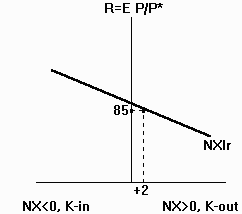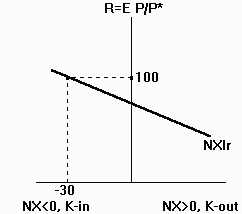Example 1--US: Reaganomics, a case of expansionary
fiscal policy (increased government spending (G) and decreased taxes (T)), 1980-1987:
|
 |
|||||||||||||||
| Jim Whitney |
Friday, January 27, 2012 |
International investment: the long run
The long-run analysis of international investment makes use
of the fundamental relationship of open-economy macroeconomics: NFI=NX, where NFI (net
foreign investment) = (S+T)-(I+G), the difference between an economy's domestic supply of
savings (S+T) and demand for savings (I+G). Basically, a country's net foreign investment
consists of any domestic savings left over after paying for domestic investment and
government purchases.
To do: Depict the new foreign-sector equilibrium in the
righthand diagrams for each of the examples below to help you predict whether you would
expect the real exchange rate (R) and current-account balance (CAB or NX) to rise (+) or
fall (-) in each case.
Example 1--US: Reaganomics, a case of expansionary
fiscal policy (increased government spending (G) and decreased taxes (T)), 1980-1987:
|
 |
|||||||||||||||
Example 2--Mexico: Mexico's currency crash, a case of
suddenly reduced foreign investor willingness to extend further credit, 1994-1995:
|
 |
|||||||||||||||